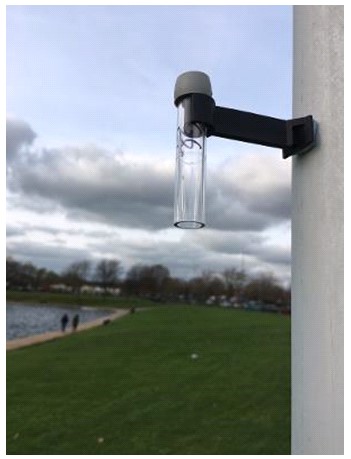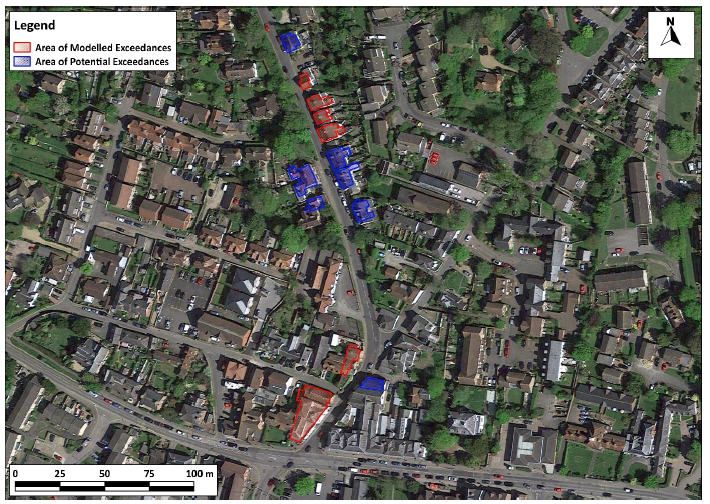Air quality
Contents
The council monitors pollution levels to assess current and future air quality. Find out what current pollution levels are and what can be done to manage and improve air quality.
The council has revised and updated the Action Plan which was approved and adopted by Cabinet on 7th March 2019 as the Air Quality Action Plan 2018 - 2023. Information and feedback received from the public consultation carried out between September and October 2018 can be found here.
The air quality in the borough has been improving steadily over recent years and we are looking to further improve it with the new action plan.
Air quality levels in the Tunbridge Wells borough
Live air quality levels are available for St John's Road, Southborough on the Kent Air website. You can find out about long term trends in pollution in our Review and Assessments Reports
Air Quality Management Area
There is an Air Quality Management Area (AQMA) along the A26, details of the location of the AQMA are detailed in the attached A26 Air Quality Management Area PDF.
What is being done to manage and improve air quality in Tunbridge Wells?
To find out what the council is doing to manage and improve air quality see the Action Plan section of this page.
Planning
Does my proposed development site cause air quality impacts?
If the development has associated traffic – potentially, yes. If the development has energy plants such as biomass or gas combined heat and power – potentially, yes.
Does my proposed development need an air quality assessment?
It depends on how much pollution may be generated and where it is situated.
Are there locations where assessments are more important?
Yes - Tunbridge Wells has an Air Quality Management Area along the A26 where air quality is poor.
Proposed development sites within this area which could cause air quality impacts generally need an air quality assessment alongside the planning application. Contact with the Environment Officer is advised before submitting such applications to determine the level of assessment if required.
What happens if the assessment shows negative impacts which would affect air quality?
Mitigation to reduce negative air quality impacts would be necessary and would need to be included in the air quality report. Those measures would then be conditioned to the planning permission if granted.
Action plan
The 2018 - 2023 Action Plan has been adopted by the council and outlines a series of measures to improve air quality.
Air quality and planning
Planning applications sometimes have to look at how the proposed development may affect the environment. Some developments may have an impact on the local air quality.
Assessments of potential air quality impacts are sometimes necessary before planning permission is granted.
To find out if your planning application could potentially affect air quality visit the planning section of this page.
Air quality in Hawkhurst
Tunbridge Wells Borough Council has been undertaking air quality monitoring in Hawkhurst, as part of its statutory duties under the Environment Act 1995.
This legislation requires all local authorities to review and assess the air quality within their area. The Act also sets limits, known as objectives, for a number of air pollutants and where these objectives are exceeded, the local authority must declare an Air Quality Management Area (AQMA). The local authority then needs to produce an Air Quality Action Plan (AQAP) describing the actions by which it intends to address the air quality issue.
The pollutant of most concern for most local authorities is nitrogen dioxide (NO2). The legislation sets two objectives for NO2; a long term one and a short term one. The short term objective applies where people spend short periods of time, for example, outdoor areas such as busy shopping streets. Exceedances of the short-term objective are very rare. There are none in Hawkhurst or anywhere else in Tunbridge Wells.
 The long term objective is based on the average level of NO2 over a full year. This applies mainly at residential property. Exceedances of this objective are quite common, and several hundred AQMAs have been declared across the country where these exceedances have occurred. The Council monitored at the front of the Colonnade for many years, and pollution levels there were always well below the annual mean objective. When monitoring was established in Cranbrook Road, higher levels of NO2 were found.
The long term objective is based on the average level of NO2 over a full year. This applies mainly at residential property. Exceedances of this objective are quite common, and several hundred AQMAs have been declared across the country where these exceedances have occurred. The Council monitored at the front of the Colonnade for many years, and pollution levels there were always well below the annual mean objective. When monitoring was established in Cranbrook Road, higher levels of NO2 were found.
We have recently commissioned specialised air quality consultants to undertake some modelling of air quality in Hawkhurst based on air quality measurements we have taken, mainly during 2019. The results of this modelling have indicated that there may be exceedances of the long term air quality objective at about 40 properties in Cranbrook Road.
The modelling has indicated that at the majority of the affected properties, any exceedance will be borderline, nevertheless, as a precautionary approach, and on the advice of the consultant, the council has taken the decision to include all 40 of the properties in the AQMA. The consultant’s report can be found in the Tunbridge Wells Annual Status Report 2020 document. (Please note: if you require an accessible version of this document email us at sustainability@tunbridgewells.gov.uk)

The main cause of elevated NO2 levels is traffic, but traffic conditions are as important as traffic volume. Pollution levels are increased where there is stop-start traffic and queuing, uphill gradients, and narrow streets with buildings on either side which prevent the pollution from dispersing and give rise to the so called ‘street canyon’ effect. At the top of Cranbrook Road all these factors are present and all contribute to the problems we have described.
What’s next?
It is important to remember that the decision to declare an AQMA in Hawkhurst is a precautionary one, based primarily on pollution levels in 2019. Based on our current knowledge, we think it’s quite likely that levels as high as these will not be seen again in Hawkhurst, although we will continue to monitor for the foreseeable future.
In 2020, pollution levels averaged out over the whole year are likely to be exceptionally low owing to the Coronavirus situation and the resultant lockdown. Therefore, we anticipate that there may well be no exceedances of the long term objective in the current year.
More generally air pollution levels are on a long term downward trend. There are a number of reasons for this, which include a move away from diesel cars, increasing numbers of electric and hybrid cars, and improvements to the bus and HGV fleet with the advent of Euro VI. We anticipate that this downward trend will continue, and probably even accelerate, so that by 2021 when traffic conditions will be back to something like normal, many of the properties will no longer be in an area of exceedance of any air quality objective.
The Air Quality Action Plan (AQAP)
In the coming months, the council will be developing the AQAP and considering what measures it can undertake to increase the air quality improvements in the area, so that the AQMA can be revoked as soon as possible. The AQAP is likely to take some time to develop, and is likely to include actions outside of our direct control. Therefore we would expect the Action Plan to take 6 to 12 months to prepare following the declaration of the AQMA. We will consult with residents about the measures to be included in the Plan.
More information can be found on our frequently asked questions page. If you have any further questions not covered by the FAQs or wish to make any comments you are able to do so by emailing us at sustainability@tunbridgewells.gov.uk. Comments can be submitted until the 12 October 2020.
Planning position statement
The council's position and guidance on any new development in Hawkhurst and the surrounding area can be found in our Planning Position Statement for proposed developments which may impact on air quality in Hawkhurst document.
Some documents on this page may not be in an accessible format. If you require any documents in an accessible format, please complete our online form to request them.